Abstract
We used the mouse mammary tumor and its associated virus (murine mammary tumor virus) to examine the possibility of using plasma levels of a viral protein (gp52, the glycoprotein of 52,000 molecular weight) as a diagnostic indicator of the presence of a solid tumor. The following features have emerged from our studies: (a) tumor-bearing animals show markedly elevated (100-1000 ng/ml) plasma levels of gp52 and the mean concentration increases with tumor size; (b) mammary tumor tissues located outside the mammary gland are also detected by the elevated plasma gp52; (c) low (2-10 ng/ml) plasma levels of gp52 are found in tumor-free mice, whether they are derived from strains characterized by high or low frequencies of spontaneous mammary tumors; (d) tumor-free lactating females exhibit the normally low levels of plasma gp52 despite the fact that their milk contains an average of 20,000 ng/ml of this antigen; (e) thus, high levels of plasma gp52 are found only in the presence of tumor and are not induced by either predisposition for the disease or by normal production of the antigen during lactation; (f) the circulatory clearance time of gp52 is sufficiently rapid to require continued replenishment to maintain the high levels observed in tumor-bearing animals, a feature implying that the gp52 concentration can be a responsive parameter of disease status. The information obtained suggests that plasma gp52 is a potentially useful and specific systemic indicator of the presence and extent of murine mammary neoplasia.
Full text
PDF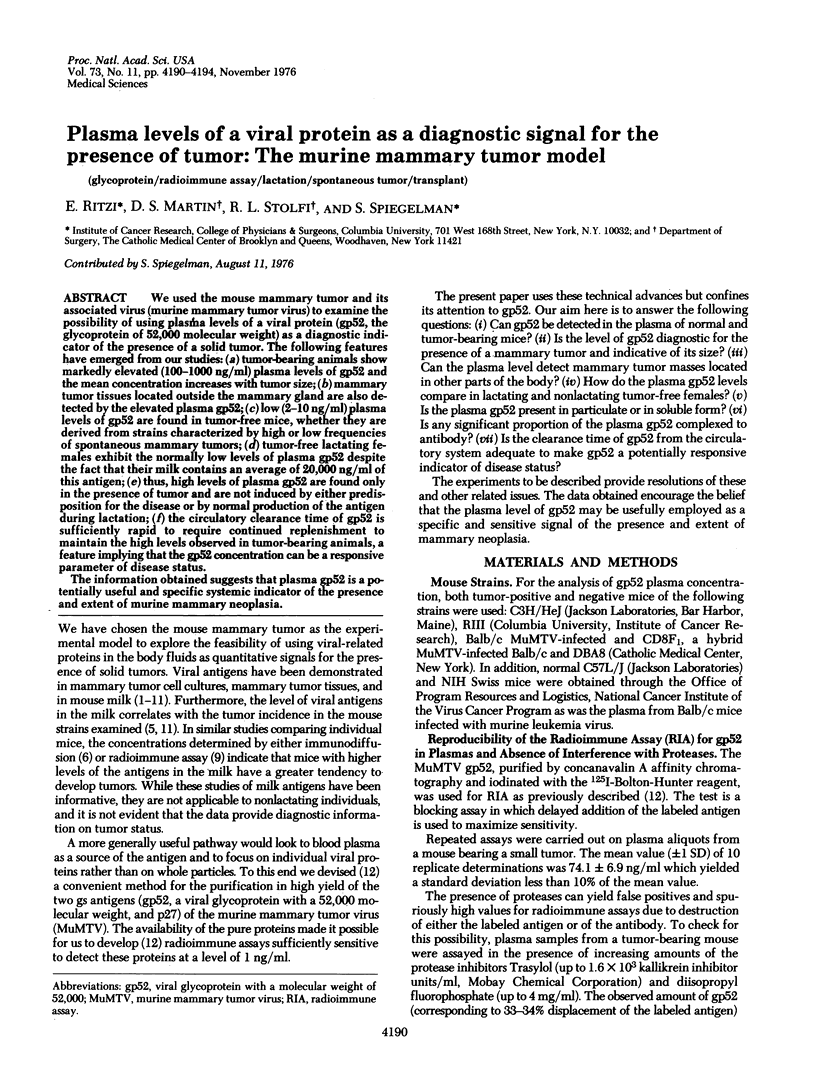
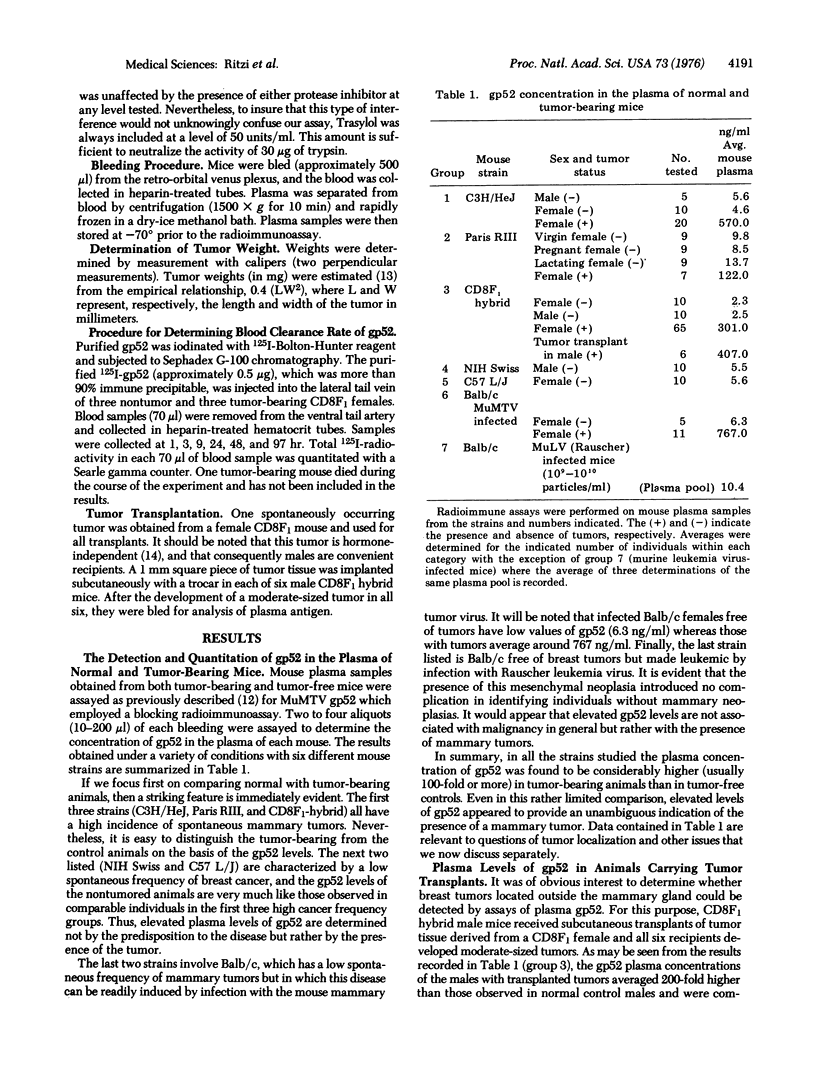
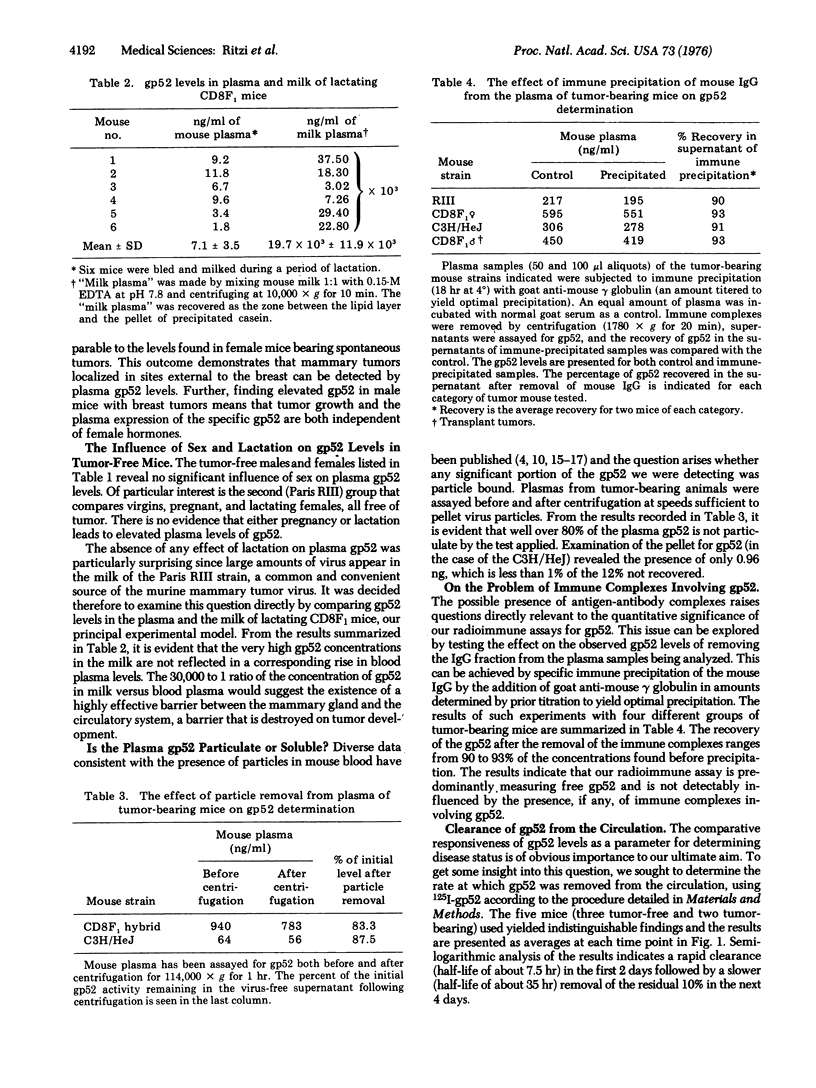
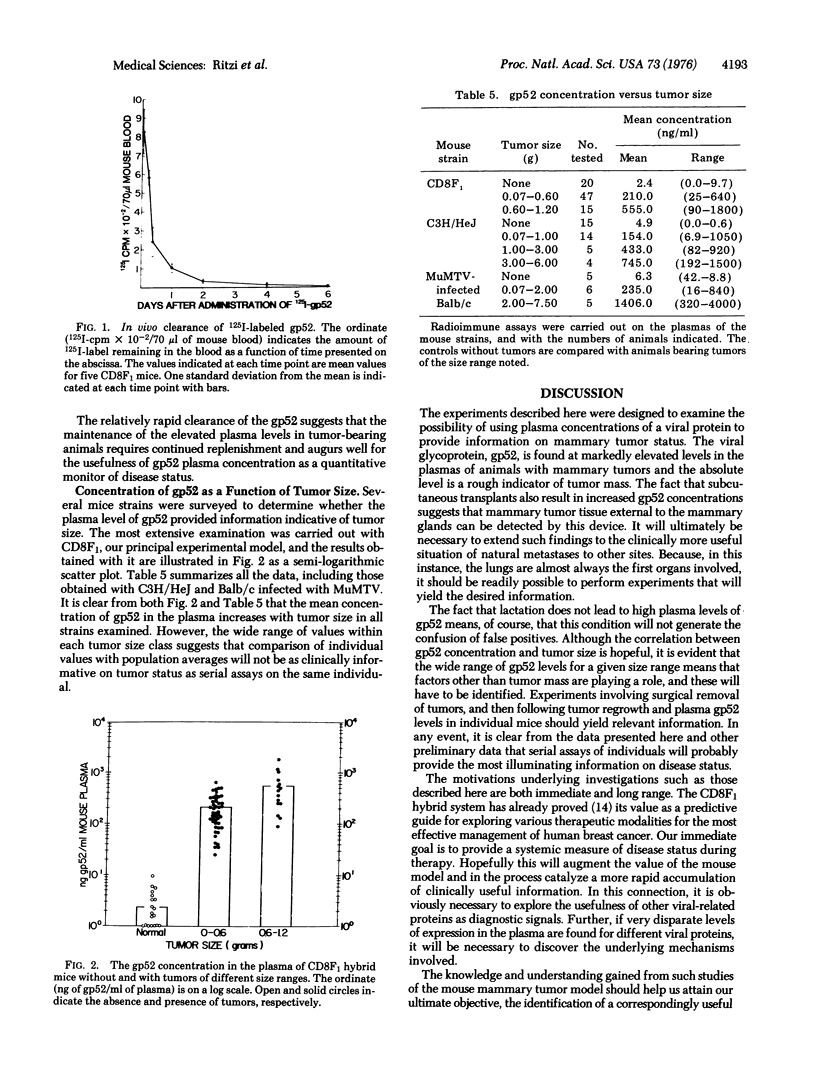
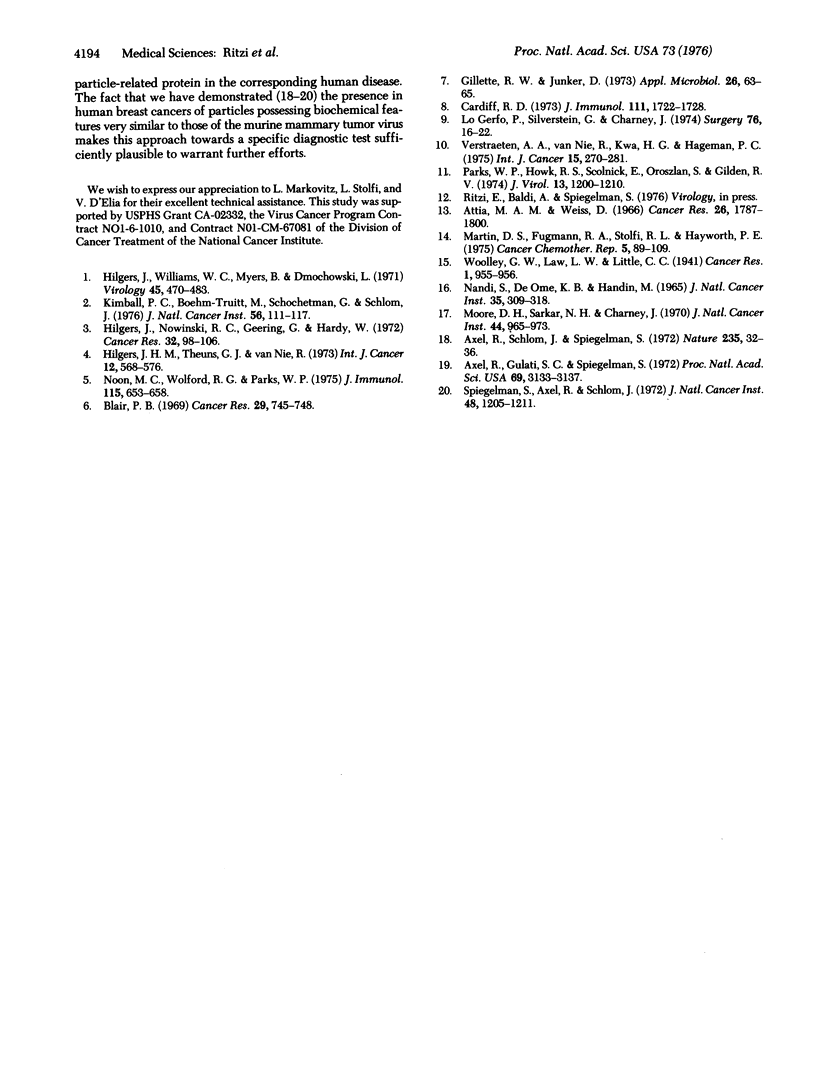
Selected References
These references are in PubMed. This may not be the complete list of references from this article.
- Attia M. A., Weiss D. W. Immunology of spontaneous mammary carcinomas in mice. V. Acquired tumor resistance and enhancement in strain A mice infected with mammary tumor virus. Cancer Res. 1966 Aug;26(8):1787–1800. [PubMed] [Google Scholar]
- Axel R., Gulati S. C., Spiegelman S. Particles containing RNA-instructed DNA polymerase and virus-related RNA in human breast cancers. Proc Natl Acad Sci U S A. 1972 Nov;69(11):3133–3137. doi: 10.1073/pnas.69.11.3133. [DOI] [PMC free article] [PubMed] [Google Scholar]
- Axel R., Schlom J., Spiegelman S. Presence in human breast cancer of RNA homologous to mouse mammary tumour virus RNA. Nature. 1972 Jan 7;235(5332):32–36. doi: 10.1038/235032a0. [DOI] [PubMed] [Google Scholar]
- Blair P. B. Detection by immunodiffusion of mouse mammary tumor virus in milk samples and correlation with tumor development. Cancer Res. 1969 Apr;29(4):745–748. [PubMed] [Google Scholar]
- Cardiff R. D. Quantitation of mouse mammary tumor virus (MTV) virions by radioimmunoassay. J Immunol. 1973 Dec;111(6):1722–1729. [PubMed] [Google Scholar]
- Gillette R. W., Junker D. Improved hemagglutination inhibition assay for mammary tumor virus antigen. Appl Microbiol. 1973 Jul;26(1):63–65. doi: 10.1128/am.26.1.63-65.1973. [DOI] [PMC free article] [PubMed] [Google Scholar]
- Hilgers J. H., Theuns G. J., van Nie R. Mammary tumor virus (MTV) antigens in normal and mammary tumor-bearing mice. Int J Cancer. 1973 Nov 15;12(3):568–576. doi: 10.1002/ijc.2910120305. [DOI] [PubMed] [Google Scholar]
- Hilgers J., Nowinski R. C., Geering G., Hardy W. Detection of avian and mammalian oncogenic RNA viruses (oncornaviruses) by immunofluorescence. Cancer Res. 1972 Jan;32(1):98–106. [PubMed] [Google Scholar]
- Hilgers J., Williams W. C., Myers B., Dmochowski L. Detection of antigens of the mouse mammary tumor (MTV) and murine leukemia virus (MuLV) in cells of cultures derived from mammary tumors of mice of several strains. Virology. 1971 Aug;45(2):470–483. doi: 10.1016/0042-6822(71)90347-3. [DOI] [PubMed] [Google Scholar]
- Kimball P. C., Boehm-Truitt M., Schochetman G., Schlom J. Characterization of mouse mammary tumor viruses from primary tumor cell cultures.I. Immunologic and structural studies. J Natl Cancer Inst. 1976 Jan;56(1):111–117. doi: 10.1093/jnci/56.1.111. [DOI] [PubMed] [Google Scholar]
- Lo Gerfo P., Silverstein G., Charney J. Radioimmunoassay for mouse mammary tumor virus-associated antigen. Surgery. 1974 Jul;76(1):16–22. [PubMed] [Google Scholar]
- Moore D. H., Sarkar N. H., Charney J. Bioactivity and virions in the blood of mice with mammary tumor virus. J Natl Cancer Inst. 1970 Apr;44(4):965–973. [PubMed] [Google Scholar]
- Nandi S., DeOme K. B., Handin M. Mammary tumor virus activity in blood and mammary tissues of C3H and BALB/cf. C3H strains of mice. J Natl Cancer Inst. 1965 Aug;35(2):309–318. [PubMed] [Google Scholar]
- Noon M. C., Wolford R. G., Parks W. P. Expression of mouse mammary tumor viral polypeptides in milks and tissues. J Immunol. 1975 Sep;115(3):653–658. [PubMed] [Google Scholar]
- Parks W. P., Howk R. S., Scolnick E. M., Oroszlan S., Gilden R. V. Immunochemical characterization of two major polypeptides from murine mammary tumor virus. J Virol. 1974 Jun;13(6):1200–1210. doi: 10.1128/jvi.13.6.1200-1210.1974. [DOI] [PMC free article] [PubMed] [Google Scholar]
- Spiegelman S., Axel R., Schlom J. Virus-related RNA in human and mouse mammary tumors. J Natl Cancer Inst. 1972 Apr;48(4):1205–1211. [PubMed] [Google Scholar]
- Verstraeten A. A., Van Nie R., Kwa H. G., Hageman P. C. Quantitative estimation of mouse mammary tumor virus (MTV) antigens by radioimmunoassay;. Int J Cancer. 1975 Feb 15;15(2):270–281. doi: 10.1002/ijc.2910150213. [DOI] [PubMed] [Google Scholar]


